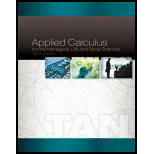
Applied Calculus for the Managerial, Life, and Social Sciences (MindTap Course List)
10th Edition
ISBN: 9781305657861
Author: Soo T. Tan
Publisher: Cengage Learning
expand_more
expand_more
format_list_bulleted
Concept explainers
Textbook Question
Chapter 8.1, Problem 25E
Find an equation of the level curve of f (x, y) =
Expert Solution & Answer
Want to see the full answer?
Check out a sample textbook solution
Chapter 8 Solutions
Applied Calculus for the Managerial, Life, and Social Sciences (MindTap Course List)
Ch. 8.1 - What is a function of two variables? Give an...Ch. 8.1 - Prob. 2CQCh. 8.1 - Prob. 3CQCh. 8.1 - Prob. 1ECh. 8.1 - Prob. 2ECh. 8.1 - Let f(x, y) = x2+ 2xy x + 3. Compute f(1, 2),...Ch. 8.1 - Prob. 4ECh. 8.1 - Prob. 5ECh. 8.1 - Prob. 6ECh. 8.1 - Let h(s, t) = s ln t t ln s. Compute h(1, e),...
Ch. 8.1 - Prob. 8ECh. 8.1 - Let g(r, s, t) = res/t. Compute g(1, 1, 1), g(1,...Ch. 8.1 - Prob. 10ECh. 8.1 - Prob. 11ECh. 8.1 - Prob. 12ECh. 8.1 - In Exercises 11-18, find the domain of the...Ch. 8.1 - Prob. 14ECh. 8.1 - In Exercises 11-18, find the domain of the...Ch. 8.1 - Prob. 16ECh. 8.1 - In Exercises 11-18, find the domain of the...Ch. 8.1 - Prob. 18ECh. 8.1 - Prob. 19ECh. 8.1 - Prob. 20ECh. 8.1 - In Exercises 19-24, sketch the level curves of the...Ch. 8.1 - Prob. 22ECh. 8.1 - In Exercises 1924, sketch the level curves of the...Ch. 8.1 - Prob. 24ECh. 8.1 - Find an equation of the level curve of f (x, y) =...Ch. 8.1 - Prob. 26ECh. 8.1 - Prob. 27ECh. 8.1 - Prob. 28ECh. 8.1 - Prob. 29ECh. 8.1 - Prob. 30ECh. 8.1 - Prob. 31ECh. 8.1 - Prob. 32ECh. 8.1 - Prob. 33ECh. 8.1 - Prob. 34ECh. 8.1 - Prob. 35ECh. 8.1 - POISEITLLES LAW Poiseuilles Law states that the...Ch. 8.1 - COST FUNCTION FOR A LOUDSPEAKER SYSTEM Acrosonic...Ch. 8.1 - Prob. 38ECh. 8.1 - REVENUE FUNCTIONS FOR DESKS Country Workshop...Ch. 8.1 - Prob. 40ECh. 8.1 - Prob. 41ECh. 8.1 - Prob. 42ECh. 8.1 - Prob. 43ECh. 8.1 - Prob. 44ECh. 8.1 - Prob. 45ECh. 8.1 - Prob. 46ECh. 8.1 - Prob. 47ECh. 8.1 - Prob. 48ECh. 8.1 - Prob. 49ECh. 8.1 - Prob. 50ECh. 8.1 - Prob. 51ECh. 8.1 - Prob. 52ECh. 8.1 - Prob. 53ECh. 8.1 - Prob. 54ECh. 8.1 - Prob. 55ECh. 8.1 - Prob. 56ECh. 8.1 - Prob. 57ECh. 8.1 - Prob. 58ECh. 8.1 - Prob. 59ECh. 8.1 - Prob. 60ECh. 8.1 - Prob. 61ECh. 8.1 - Prob. 62ECh. 8.1 - Prob. 63ECh. 8.1 - Prob. 64ECh. 8.2 - Prob. 1CQCh. 8.2 - Prob. 2CQCh. 8.2 - Prob. 3CQCh. 8.2 - Prob. 4CQCh. 8.2 - Prob. 1ECh. 8.2 - Prob. 2ECh. 8.2 - Prob. 3ECh. 8.2 - Prob. 4ECh. 8.2 - Prob. 5ECh. 8.2 - Prob. 6ECh. 8.2 - Prob. 7ECh. 8.2 - Prob. 8ECh. 8.2 - Prob. 9ECh. 8.2 - Prob. 10ECh. 8.2 - In Exercises 3-24, find the first partial...Ch. 8.2 - Prob. 12ECh. 8.2 - Prob. 13ECh. 8.2 - Prob. 14ECh. 8.2 - Prob. 15ECh. 8.2 - Prob. 16ECh. 8.2 - Prob. 17ECh. 8.2 - Prob. 18ECh. 8.2 - Prob. 19ECh. 8.2 - Prob. 20ECh. 8.2 - Prob. 21ECh. 8.2 - Prob. 22ECh. 8.2 - Prob. 23ECh. 8.2 - Prob. 24ECh. 8.2 - Prob. 25ECh. 8.2 - Prob. 26ECh. 8.2 - Prob. 27ECh. 8.2 - Prob. 28ECh. 8.2 - Prob. 29ECh. 8.2 - Prob. 30ECh. 8.2 - Prob. 31ECh. 8.2 - Prob. 32ECh. 8.2 - Prob. 33ECh. 8.2 - Prob. 34ECh. 8.2 - Prob. 35ECh. 8.2 - Prob. 36ECh. 8.2 - Prob. 37ECh. 8.2 - Prob. 38ECh. 8.2 - Prob. 39ECh. 8.2 - Prob. 40ECh. 8.2 - Prob. 41ECh. 8.2 - Prob. 42ECh. 8.2 - Prob. 43ECh. 8.2 - Prob. 44ECh. 8.2 - Prob. 45ECh. 8.2 - Prob. 46ECh. 8.2 - Prob. 47ECh. 8.2 - Prob. 48ECh. 8.2 - PROFIT FUNCTIONS The monthly profit (in dollars)...Ch. 8.2 - Prob. 50ECh. 8.2 - Prob. 51ECh. 8.2 - Prob. 52ECh. 8.2 - Prob. 54ECh. 8.2 - Prob. 55ECh. 8.2 - Prob. 56ECh. 8.2 - Prob. 57ECh. 8.2 - Prob. 58ECh. 8.2 - Prob. 59ECh. 8.2 - Prob. 60ECh. 8.2 - Prob. 61ECh. 8.2 - Prob. 62ECh. 8.2 - Prob. 63ECh. 8.2 - Prob. 64ECh. 8.2 - Prob. 66ECh. 8.2 - Prob. 67ECh. 8.2 - Prob. 68ECh. 8.2 - Prob. 69ECh. 8.2 - Prob. 70ECh. 8.2 - Prob. 72ECh. 8.2 - Prob. 1TECh. 8.2 - Prob. 2TECh. 8.2 - Prob. 3TECh. 8.2 - Prob. 4TECh. 8.2 - Prob. 5TECh. 8.2 - Prob. 6TECh. 8.3 - Explain the terms (a) relative maximum of a...Ch. 8.3 - Prob. 2CQCh. 8.3 - Prob. 3CQCh. 8.3 - Prob. 4CQCh. 8.3 - Prob. 1ECh. 8.3 - Prob. 2ECh. 8.3 - Prob. 3ECh. 8.3 - Prob. 4ECh. 8.3 - In Exercises 1-20, find the critical point(s) of...Ch. 8.3 - In Exercises 1-20, find the critical point(s) of...Ch. 8.3 - Prob. 7ECh. 8.3 - Prob. 8ECh. 8.3 - Prob. 9ECh. 8.3 - Prob. 10ECh. 8.3 - Prob. 11ECh. 8.3 - Prob. 12ECh. 8.3 - Prob. 13ECh. 8.3 - Prob. 14ECh. 8.3 - Prob. 15ECh. 8.3 - Prob. 16ECh. 8.3 - Prob. 17ECh. 8.3 - Prob. 18ECh. 8.3 - Prob. 19ECh. 8.3 - Prob. 20ECh. 8.3 - MAXIMIZATION PROFIT The total weekly revenue (in...Ch. 8.3 - Prob. 22ECh. 8.3 - Prob. 23ECh. 8.3 - Prob. 24ECh. 8.3 - MAXIMIZING REVENUE The management of Cal...Ch. 8.3 - Prob. 26ECh. 8.3 - MAXIMIZING PROFIT Johnsons Household Products has...Ch. 8.3 - Prob. 28ECh. 8.3 - Prob. 29ECh. 8.3 - Prob. 30ECh. 8.3 - Prob. 31ECh. 8.3 - Prob. 32ECh. 8.3 - Prob. 33ECh. 8.3 - Prob. 34ECh. 8.3 - Prob. 35ECh. 8.3 - Prob. 36ECh. 8.3 - Prob. 37ECh. 8.3 - Prob. 38ECh. 8.3 - Prob. 39ECh. 8.3 - Prob. 40ECh. 8.3 - Prob. 41ECh. 8.3 - Prob. 42ECh. 8.4 - Explain the terms (a) scatter diagram and (b)...Ch. 8.4 - Prob. 2CQCh. 8.4 - Prob. 4CQCh. 8.4 - Prob. 1ECh. 8.4 - Prob. 2ECh. 8.4 - In Exercises 16, (a) find an equation of the...Ch. 8.4 - Prob. 4ECh. 8.4 - Prob. 5ECh. 8.4 - Prob. 6ECh. 8.4 - COLLEGE ADMISSIONS The following data, compiled by...Ch. 8.4 - Prob. 8ECh. 8.4 - Prob. 9ECh. 8.4 - Prob. 10ECh. 8.4 - Prob. 11ECh. 8.4 - Prob. 12ECh. 8.4 - Prob. 13ECh. 8.4 - Prob. 14ECh. 8.4 - Prob. 15ECh. 8.4 - Prob. 16ECh. 8.4 - Prob. 17ECh. 8.4 - Prob. 18ECh. 8.4 - Prob. 19ECh. 8.4 - Prob. 20ECh. 8.4 - Prob. 21ECh. 8.4 - Prob. 22ECh. 8.4 - Prob. 23ECh. 8.4 - Prob. 24ECh. 8.4 - Prob. 25ECh. 8.4 - Prob. 26ECh. 8.4 - Prob. 27ECh. 8.4 - Prob. 29ECh. 8.4 - Prob. 30ECh. 8.4 - Prob. 1TECh. 8.4 - Prob. 2TECh. 8.4 - Prob. 3TECh. 8.4 - Prob. 4TECh. 8.4 - Prob. 5TECh. 8.4 - Prob. 6TECh. 8.4 - Prob. 7TECh. 8.4 - Prob. 8TECh. 8.4 - Prob. 9TECh. 8.5 - What is a constrained relative extremum of a...Ch. 8.5 - Prob. 2CQCh. 8.5 - Prob. 1ECh. 8.5 - Prob. 2ECh. 8.5 - Prob. 3ECh. 8.5 - Prob. 4ECh. 8.5 - Prob. 5ECh. 8.5 - Prob. 6ECh. 8.5 - Prob. 7ECh. 8.5 - Prob. 8ECh. 8.5 - Prob. 9ECh. 8.5 - Prob. 10ECh. 8.5 - In Exercises 1-16. use the method of Lagrange...Ch. 8.5 - Prob. 12ECh. 8.5 - In Exercises 1-16. use the method of Lagrange...Ch. 8.5 - Prob. 14ECh. 8.5 - Prob. 15ECh. 8.5 - Prob. 16ECh. 8.5 - MAXIMIZING PROFIT The total weekly profit (in...Ch. 8.5 - Prob. 18ECh. 8.5 - Prob. 19ECh. 8.5 - Prob. 20ECh. 8.5 - PACKAGING Find the dimensions of an open...Ch. 8.5 - Prob. 22ECh. 8.5 - Prob. 23ECh. 8.5 - Prob. 24ECh. 8.5 - MINIMIZING CONTAINER COSTS The Betty Moore Company...Ch. 8.5 - Prob. 26ECh. 8.5 - Prob. 27ECh. 8.5 - Prob. 28ECh. 8.5 - Prob. 29ECh. 8.5 - Prob. 30ECh. 8.5 - Prob. 31ECh. 8.5 - Prob. 33ECh. 8.5 - Prob. 34ECh. 8.5 - Prob. 36ECh. 8.5 - Prob. 38ECh. 8.5 - Prob. 39ECh. 8.5 - Prob. 40ECh. 8.5 - Prob. 41ECh. 8.5 - Prob. 42ECh. 8.6 - Prob. 1CQCh. 8.6 - Prob. 2CQCh. 8.6 - Prob. 1ECh. 8.6 - Prob. 2ECh. 8.6 - Prob. 3ECh. 8.6 - Prob. 4ECh. 8.6 - Prob. 5ECh. 8.6 - Prob. 6ECh. 8.6 - Prob. 7ECh. 8.6 - Prob. 8ECh. 8.6 - Prob. 9ECh. 8.6 - Prob. 10ECh. 8.6 - Prob. 11ECh. 8.6 - Prob. 12ECh. 8.6 - Prob. 13ECh. 8.6 - Prob. 14ECh. 8.6 - In Exercises 318, find the total differential of...Ch. 8.6 - Prob. 16ECh. 8.6 - Prob. 17ECh. 8.6 - Prob. 18ECh. 8.6 - Prob. 19ECh. 8.6 - Prob. 20ECh. 8.6 - Prob. 21ECh. 8.6 - Prob. 22ECh. 8.6 - Prob. 23ECh. 8.6 - Prob. 24ECh. 8.6 - Prob. 25ECh. 8.6 - Prob. 26ECh. 8.6 - Prob. 27ECh. 8.6 - Prob. 28ECh. 8.6 - Prob. 29ECh. 8.6 - Prob. 30ECh. 8.6 - Prob. 31ECh. 8.6 - Prob. 32ECh. 8.6 - Prob. 33ECh. 8.6 - Prob. 34ECh. 8.6 - Prob. 35ECh. 8.6 - Prob. 36ECh. 8.6 - Prob. 37ECh. 8.6 - Prob. 38ECh. 8.6 - Prob. 39ECh. 8.6 - Prob. 40ECh. 8.6 - Prob. 41ECh. 8.6 - Prob. 42ECh. 8.6 - Prob. 43ECh. 8.6 - Prob. 44ECh. 8.6 - Prob. 45ECh. 8.6 - Prob. 46ECh. 8.6 - Prob. 47ECh. 8.6 - Prob. 48ECh. 8.7 - Prob. 1CQCh. 8.7 - Prob. 2CQCh. 8.7 - Prob. 3CQCh. 8.7 - Prob. 4CQCh. 8.7 - Prob. 1ECh. 8.7 - Prob. 2ECh. 8.7 - Prob. 3ECh. 8.7 - Prob. 4ECh. 8.7 - Prob. 5ECh. 8.7 - Prob. 6ECh. 8.7 - Prob. 7ECh. 8.7 - Prob. 8ECh. 8.7 - Prob. 9ECh. 8.7 - Prob. 10ECh. 8.7 - Prob. 11ECh. 8.7 - Prob. 12ECh. 8.7 - Prob. 13ECh. 8.7 - Prob. 14ECh. 8.7 - Prob. 15ECh. 8.7 - Prob. 16ECh. 8.7 - Prob. 17ECh. 8.7 - Prob. 18ECh. 8.7 - In Exercises 1-25. evaluate the double integral...Ch. 8.7 - Prob. 20ECh. 8.7 - Prob. 21ECh. 8.7 - Prob. 22ECh. 8.7 - Prob. 23ECh. 8.7 - Prob. 24ECh. 8.7 - Prob. 25ECh. 8.7 - Prob. 26ECh. 8.7 - Prob. 27ECh. 8.8 - Prob. 1CQCh. 8.8 - Prob. 2CQCh. 8.8 - Prob. 3CQCh. 8.8 - Prob. 1ECh. 8.8 - Prob. 2ECh. 8.8 - Prob. 3ECh. 8.8 - Prob. 4ECh. 8.8 - Prob. 5ECh. 8.8 - Prob. 6ECh. 8.8 - Prob. 7ECh. 8.8 - Prob. 8ECh. 8.8 - Prob. 9ECh. 8.8 - Prob. 10ECh. 8.8 - Prob. 11ECh. 8.8 - Prob. 12ECh. 8.8 - Prob. 13ECh. 8.8 - Prob. 14ECh. 8.8 - Prob. 15ECh. 8.8 - Prob. 16ECh. 8.8 - Prob. 17ECh. 8.8 - Prob. 18ECh. 8.8 - Prob. 19ECh. 8.8 - Prob. 20ECh. 8.8 - Prob. 21ECh. 8.8 - Prob. 22ECh. 8.8 - Prob. 23ECh. 8.8 - Prob. 24ECh. 8.8 - Prob. 25ECh. 8.8 - Prob. 26ECh. 8.8 - Prob. 27ECh. 8.8 - Prob. 28ECh. 8.8 - Prob. 29ECh. 8 - Prob. 1CRQCh. 8 - Prob. 2CRQCh. 8 - Prob. 3CRQCh. 8 - Prob. 4CRQCh. 8 - Prob. 5CRQCh. 8 - Prob. 6CRQCh. 8 - Prob. 7CRQCh. 8 - Prob. 8CRQCh. 8 - Prob. 9CRQCh. 8 - Prob. 10CRQCh. 8 - Prob. 11CRQCh. 8 - Prob. 12CRQCh. 8 - Prob. 13CRQCh. 8 - Prob. 1RECh. 8 - Prob. 2RECh. 8 - Prob. 3RECh. 8 - Prob. 4RECh. 8 - Prob. 5RECh. 8 - Prob. 6RECh. 8 - Prob. 7RECh. 8 - Prob. 8RECh. 8 - Prob. 9RECh. 8 - Prob. 10RECh. 8 - Prob. 11RECh. 8 - Prob. 12RECh. 8 - Prob. 13RECh. 8 - Prob. 14RECh. 8 - Prob. 15RECh. 8 - Prob. 16RECh. 8 - Prob. 17RECh. 8 - Prob. 18RECh. 8 - Prob. 19RECh. 8 - Prob. 20RECh. 8 - Prob. 21RECh. 8 - Prob. 22RECh. 8 - Prob. 23RECh. 8 - Prob. 24RECh. 8 - Prob. 25RECh. 8 - Prob. 26RECh. 8 - Prob. 27RECh. 8 - Prob. 28RECh. 8 - Prob. 29RECh. 8 - Prob. 30RECh. 8 - Prob. 31RECh. 8 - Prob. 32RECh. 8 - Prob. 33RECh. 8 - Prob. 34RECh. 8 - Prob. 35RECh. 8 - Prob. 36RECh. 8 - Prob. 37RECh. 8 - Prob. 38RECh. 8 - Prob. 39RECh. 8 - Prob. 40RECh. 8 - Prob. 41RECh. 8 - Prob. 42RECh. 8 - Prob. 43RECh. 8 - Prob. 44RECh. 8 - Prob. 45RECh. 8 - Prob. 46RECh. 8 - Prob. 47RECh. 8 - Prob. 48RECh. 8 - Prob. 49RECh. 8 - Prob. 50RECh. 8 - Prob. 51RECh. 8 - Prob. 52RECh. 8 - Prob. 53RECh. 8 - Prob. 54RECh. 8 - Prob. 55RECh. 8 - Prob. 56RECh. 8 - Prob. 57RECh. 8 - Prob. 59RECh. 8 - Prob. 60RECh. 8 - Prob. 61RECh. 8 - Prob. 62RECh. 8 - Prob. 1BMCh. 8 - Prob. 2BMCh. 8 - Prob. 3BMCh. 8 - Prob. 4BMCh. 8 - Prob. 5BMCh. 8 - Prob. 6BMCh. 8 - Prob. 7BM
Knowledge Booster
Learn more about
Need a deep-dive on the concept behind this application? Look no further. Learn more about this topic, calculus and related others by exploring similar questions and additional content below.Similar questions
- Find an equation of the tangent line to the parabola y=3x2 at the point 1,3.arrow_forwardbThe average rate of change of the linear function f(x)=3x+5 between any two points is ________.arrow_forwardHow are the absolute maximum and minimum similar to and different from the local extrema?arrow_forward
Recommended textbooks for you
 Trigonometry (MindTap Course List)TrigonometryISBN:9781337278461Author:Ron LarsonPublisher:Cengage Learning
Trigonometry (MindTap Course List)TrigonometryISBN:9781337278461Author:Ron LarsonPublisher:Cengage Learning Glencoe Algebra 1, Student Edition, 9780079039897...AlgebraISBN:9780079039897Author:CarterPublisher:McGraw Hill
Glencoe Algebra 1, Student Edition, 9780079039897...AlgebraISBN:9780079039897Author:CarterPublisher:McGraw Hill Algebra and Trigonometry (MindTap Course List)AlgebraISBN:9781305071742Author:James Stewart, Lothar Redlin, Saleem WatsonPublisher:Cengage Learning
Algebra and Trigonometry (MindTap Course List)AlgebraISBN:9781305071742Author:James Stewart, Lothar Redlin, Saleem WatsonPublisher:Cengage Learning

Trigonometry (MindTap Course List)
Trigonometry
ISBN:9781337278461
Author:Ron Larson
Publisher:Cengage Learning

Glencoe Algebra 1, Student Edition, 9780079039897...
Algebra
ISBN:9780079039897
Author:Carter
Publisher:McGraw Hill

Algebra and Trigonometry (MindTap Course List)
Algebra
ISBN:9781305071742
Author:James Stewart, Lothar Redlin, Saleem Watson
Publisher:Cengage Learning

01 - What Is A Differential Equation in Calculus? Learn to Solve Ordinary Differential Equations.; Author: Math and Science;https://www.youtube.com/watch?v=K80YEHQpx9g;License: Standard YouTube License, CC-BY
Higher Order Differential Equation with constant coefficient (GATE) (Part 1) l GATE 2018; Author: GATE Lectures by Dishank;https://www.youtube.com/watch?v=ODxP7BbqAjA;License: Standard YouTube License, CC-BY
Solution of Differential Equations and Initial Value Problems; Author: Jefril Amboy;https://www.youtube.com/watch?v=Q68sk7XS-dc;License: Standard YouTube License, CC-BY